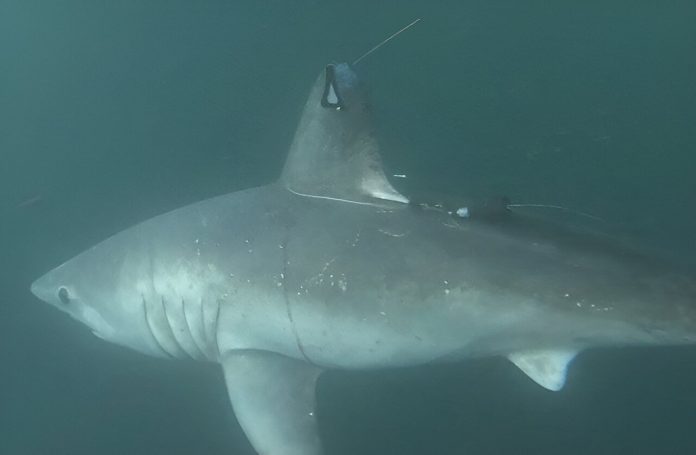
In a twist straight out of a marine mystery novel, scientists have discovered that large sharks may be hunting each other.
The evidence?
A tracking tag that was swallowed whole.
This remarkable story, published in Frontiers in Marine Science, focuses on the death of a pregnant porbeagle shark, and researchers believe it was likely killed by a larger shark.
Dr. Brooke Anderson, a former graduate student at Arizona State University, led the study. “This is the first documented case of a porbeagle shark being eaten by another shark,” she said.
“It’s significant because not only was a reproductive female lost, but all her developing babies were lost too. If this type of predation happens more often than we thought, it could seriously affect the porbeagle population, which is already struggling due to overfishing.”
The Porbeagle Shark
Porbeagles are powerful, fast-swimming sharks found in the Atlantic, South Pacific, and Mediterranean.
They can grow up to 3.7 meters long and weigh as much as 230 kg. They are long-lived creatures, with some surviving up to 65 years. However, porbeagle females take a long time to reproduce—around 13 years. When they do, they give birth to an average of four pups every one or two years after carrying them for eight to nine months.
Because of their slow reproduction, porbeagle populations can’t bounce back quickly from threats like overfishing, accidental catches, and habitat loss.
In fact, porbeagles in the Northwest Atlantic are listed as endangered, while populations in the Northeast Atlantic and the Mediterranean are critically endangered.
In 2020 and 2022, Dr. Anderson and her team captured and tagged porbeagle sharks near Cape Cod, Massachusetts, to study their migration patterns.
The sharks were fitted with two types of satellite tags: a fin-mounted transmitter and a pop-off satellite archival tag (PSAT). The fin-mounted tag sends location signals whenever the shark’s fin breaks the water’s surface. The PSAT records depth and temperature, then pops off after a set time and transmits the data to satellites.
One of the sharks they tagged was a pregnant female, measuring 2.2 meters long.
The team hoped her movements would provide valuable data about important habitats for porbeagle mothers and their pups. But the study took a tragic turn.
The Death of the Porbeagle
The pregnant porbeagle was cruising the ocean depths for five months, moving between 100 and 800 meters deep, according to the PSAT data.
But in March 2021, something changed. Over a period of four days, the temperature readings became steady at around 22°C, and the shark remained between 150 and 600 meters deep.
The only possible explanation? The shark had been eaten by a larger predator, and the tag was stuck inside the predator’s body before being excreted four days later.
Who Was the Killer?
Two suspects emerged in this sharky whodunnit: the great white shark and the shortfin mako. Both are large predators capable of hunting porbeagles.
Shortfin mako sharks are known to eat a wide variety of prey, including fish, small sharks, and even sea turtles, while great whites are famous for hunting larger prey like seals, dolphins, and whales.
Based on the data from the PSAT, the scientists concluded that a great white shark was the most likely culprit, as the recorded behavior matched that of a white shark rather than a shortfin mako.
What This Means for Shark Populations
The death of the pregnant porbeagle shocked the research team. “We usually think of large sharks as being at the top of the food chain,” said Dr. Anderson. “But this case shows us that there may be more complex interactions between sharks than we realized.”
The researchers believe that understanding how often large sharks prey on each other is important for understanding the broader ecosystem. If such events happen frequently, they could have far-reaching effects on shark populations and the marine environment.
This study highlights the need for more research into shark behavior and predator interactions to ensure we protect vulnerable species like the porbeagle.



